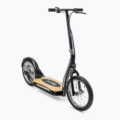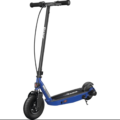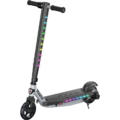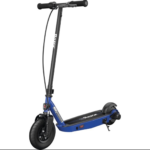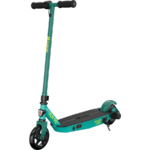- Home
- Scooters
- Electric Scooters
- Razor Power Core XLR100
Razor Power Core XLR100
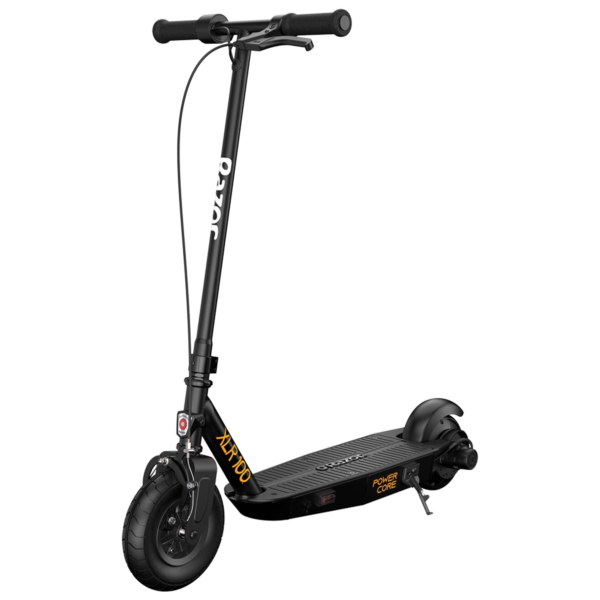

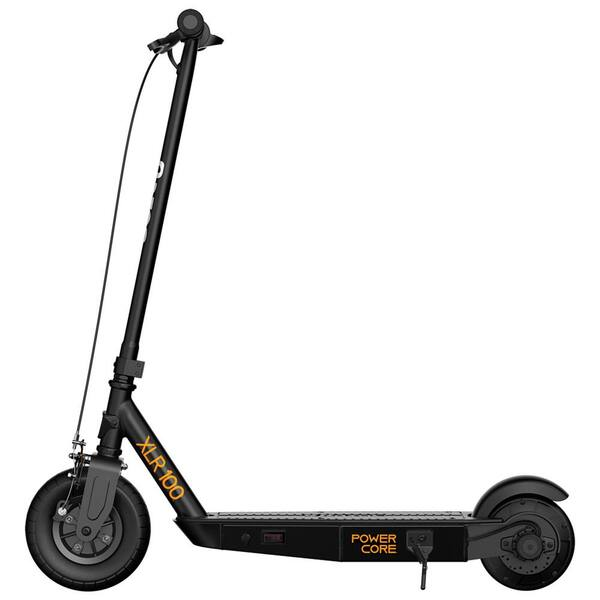
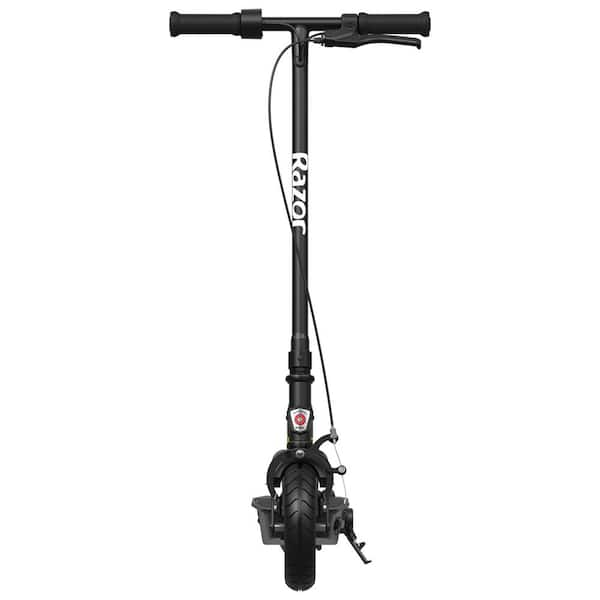
- Battery Range: 10 mi (16 km)
- Top Speed: 10 mph (16 km/h)
- Motor Power: 100 W nominal
- Weight Capacity: 132 lb (60 kg)
- Charging Time: ~4–5 h
- Scooter Weight: 22.0 lb (10.0 kg)
PROS
- Slightly stronger hub motor
- Kid-friendly 10 mph cap
- Solid tires and simple upkeep
- Lightweight, easy to carry
- LED visibility (model-dependent)
CONS
- Not for adult riders
- Shorter range for long outings
- No suspension
- Lower weight capacity

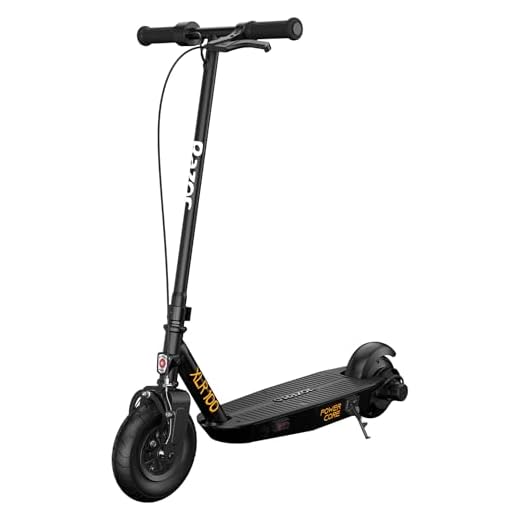
Table of contents
- What Is the Razor Power Core XLR100?
- How the Razor Power Core XLR100 Works
- Key Specifications (clean table)
- Design & Build Quality
- Performance Fundamentals
- Battery, Range & Efficiency
- Ride Quality & Comfort
- Braking & Safety Features
- Portability & Daily Usability
- Maintenance & Care
- Weather & Seasonal Considerations
- Razor Power Core XLR100 vs Alternatives
- Who the Razor Power Core XLR100 Is (and Isn’t) For
- FAQs
- Glossary
- Final Thoughts
Electric scooters simplify short trips, and they make daily movement more fun. The Razor Power Core XLR100 aims at riders who want a straightforward, low-maintenance scooter for neighborhood rides and last-mile hops. It favors reliability over flash. Consequently, it suits beginners, students, and casual riders who value ease of use, predictable handling, and simple care.
What Is the Razor Power Core XLR100?
The Razor Power Core XLR100 is a lightweight, hub-motor scooter built for everyday errands and short commutes. It emphasizes simple operation and durable parts. There are no complex app menus to learn. There are no fragile decorative gadgets to fail. Instead, you get a compact platform, a sealed motor, and a battery pack designed for steady, repeatable rides.
This scooter sits in the “entry and casual” category. It is not a high-speed machine, and it is not an off-road toy. Rather, it is a paved-path companion that focuses on balance and safety basics. Because of this focus, new riders often feel comfortable within minutes. Meanwhile, experienced riders appreciate the predictable steering and quiet drivetrain. City users like how it stores under a desk and fits in a car trunk. In short, it strives to remove friction from local travel.
How the Razor Power Core XLR100 Works
Although scooters feel magical, the technology is approachable. Think of it like a small, efficient electric system that converts stored energy into smooth wheel rotation.
Motor. The XLR100 uses a rear hub motor. The motor sits inside the wheel, which keeps the drivetrain quiet and sealed from dust. There is no external chain or belt to adjust. When you press the throttle, current flows to the motor windings. The motor generates torque, and the wheel turns with little vibration. As a result, the ride feels calm and controlled. For a deeper primer on hub vs belt vs chain drive efficiency, noise, and maintenance, this overview explains the trade-offs clearly.
Controller. The controller is the scooter’s brain. It measures throttle input and battery status. Then it modulates power so the ride feels steady. Imagine using a light dimmer instead of a simple on/off switch. The controller does that for the motor, thousands of times per second. Therefore, acceleration arrives smoothly rather than in jolts.
Battery. The battery stores energy for the ride. In practice, the pack provides a fixed voltage and a certain amount of capacity. Capacity dictates potential range, while voltage affects power behavior. The pack is managed to protect it from over-charging and over-discharging. Consequently, the scooter delivers repeatable range when you ride under similar conditions.
Throttle. The thumb throttle is the main control. Pressing it requests power. Release it to coast. The modulation feels intuitive, even for first-time riders. Because it is not twitchy, it helps keep speed changes smooth in busy areas. Additionally, it reduces wrist strain on longer outings.
Brakes. The scooter uses a mechanical brake, typically actuated by a hand lever or foot fender, depending on model configuration. When you brake, friction converts motion into heat, and the scooter slows quickly. The setup favors simple maintenance and consistent feel. Furthermore, it remains predictable across dry and mildly wet surfaces.
Together, these parts form a closed system. You charge the battery. You step on the deck. You press the throttle. The motor converts electrical energy into motion. You brake to stop. With routine checks, this system stays reliable for years.
Key Specifications (clean table)
The table below summarizes the core setup in a practical, rider-oriented way. Where the maker does not publish exact figures, items are described functionally.
| Block | Details |
|---|---|
| General | Category: everyday/casual riding; Drivetrain: rear hub motor; Frame: metal chassis with protective bodywork; Deck: grippy standing surface for stable stance; Cockpit: simple throttle and brake controls; Tires: urban-focused size for paved paths. |
| Performance & Power | Motor Type: brushless hub motor; Drive: rear-wheel; Controller: sealed DC controller for smooth modulation; Top-end behavior: tuned for safe neighborhood speeds; Hill capability: handles mild grades with a running start; Noise: low mechanical noise, mostly tire hum. |
| Battery, Charging & Electrical | Battery: sealed pack with protected charge/discharge; Charging: external charger with status indicator; Estimated charge time: several hours from low to full; Power delivery: steady, beginner-friendly ramp; Electrical protection: fused and managed for safety. |
| Build & Dimensions | Chassis: compact and portable; Deck length/width: sized for a shoulder-width stance; Stem: foldable for storage; Folded dimensions: slim profile to fit under desks or in trunks (maker does not publish exact numbers); Weight: light enough for short carries up stairs. |
| Safety & Control | Brake: mechanical system with consistent lever feel; Lighting: front and/or rear visibility elements and reflectors; Traction: tread pattern suited to pavement; Stability: neutral steering with predictable lean. |
| Features & Extras | Kickstand: yes; Folding latch: simple and secure when locked; Cruise Control: typically not included in this class; Display: basic status indicators; Accessory compatibility: common add-ons such as bells or extra reflectors. |
| Warranty & Compliance | Warranty: limited manufacturer coverage; Compliance: follow local rules on speed and where you may ride; Intended Use: paved surfaces and bike-path conditions. |
(Note: Items are presented to support daily use rather than to list every lab number.)
Design & Build Quality
A scooter’s frame dictates its character. The Razor Power Core XLR100 uses a simple metal chassis with a sturdy deck and a foldable stem. The structure feels unified and free of drama. It resists creaks and flex if you keep fasteners snug. The deck finish offers grip even when shoes are slightly wet, and the edges are rounded so they do not snag pants or bags. Because the motor is in the rear wheel, the bodywork looks clean. There is no chain guard or belt cover to bump. Consequently, the silhouette stays sleek and easy to carry.
The cockpit is intentionally minimal. A thumb throttle on the right makes acceleration natural, like paging through a phone. The brake lever sits on the left, which mirrors a bicycle layout. This symmetry helps first-time riders because the controls feel familiar. The cables and wires are routed along the stem and frame. The routing limits snags when you lock the scooter or slide it into a trunk. Moreover, tidy routing protects wiring from accidental pulls.
Fit-and-finish matters on small vehicles. Panel gaps should be even. Hardware should be treated to resist corrosion. On the XLR100, the surface coatings protect against minor scuffs and light rain. You will still want to wipe the scooter dry after wet rides, as that habit preserves hardware and keeps the deck clean. Additionally, a quick wipe makes pre-ride checks faster because dirt no longer hides loose fasteners.
Finally, the folding joint is the lifeline of portability. The latch closes with a positive action, and it remains solid when locked. As always, check the latch weekly. A one-minute inspection prevents rattles and protects the hinge from wear. In turn, the stem stays quiet and steering remains precise.
Performance Fundamentals
Performance is not only about speed. It is about control, balance, and predictability. The Razor Power Core XLR100 chooses a calm tune. As you roll on the throttle, power ramps in smoothly. There is no sudden lurch. That smoothness helps in narrow spaces. It also helps when you ride alongside pedestrians or on a bike path.
Acceleration feel. Off the line, the scooter nudges forward with steady torque. The rear hub adds traction, since your weight sits near the drive wheel. On flat ground, the scooter builds to its cruising pace without drama. Because torque delivery is even, it is easy to hold a chosen speed. Additionally, the stable ramp helps new riders avoid over-correction.
Cruising stability. At typical neighborhood speeds, the chassis feels composed. The wheelbase and steering angle encourage straight tracking. Gentle corrections keep the scooter centered. If you stand with one foot forward and one foot back, the platform feels locked-in. Therefore, fatigue stays low even during longer loops.
Hill behavior. On gentle grades around 7–10%, expect speed to sag compared to flat ground. That behavior is normal for compact hub scooters. A small running start helps. Keep your posture tall and let the motor pull. If your route includes long hills, plan range with a buffer. Conversely, on flat routes you can budget more distance.
Noise and vibration. Motor whine is low. Most sound comes from tires. On smoother pavement, the ride is quiet enough to chat. On rough asphalt, you will hear a steady hum, which is typical and not a concern. Meanwhile, the lack of chain noise keeps the soundtrack clean.
Battery, Range & Efficiency
Real-world range depends on many factors. Rider weight matters. Average speed matters. Temperature matters. So does terrain and tire pressure. Because of these variables, it is best to treat range as a flexible envelope rather than a fixed promise.
Rated vs. real-world. The pack is sized for short trips and daily errands. In steady conditions on flat ground, you can complete neighborhood loops and campus runs without anxiety. If your route includes frequent hills, expect the range envelope to shrink. Conversely, if you ride slower on warm days with light winds, range expands.
Efficiency habits that help. Keep tires properly inflated if your model uses pneumatic tires. If the scooter uses solids, check them for cuts and embedded debris. Ride at a steady pace rather than full-throttle bursts. Ease off before you crest hills. Coast down gentle slopes. These micro-habits extend range without sacrificing time. In practice, they also reduce heat buildup in the motor and controller.
Charging best practices. Charge after rides that bring the battery below roughly half. Don’t store the scooter fully empty. Do not leave it in a hot car. High heat degrades cells. Extreme cold reduces power output. As a result, charge indoors and let the scooter warm to room temperature before you plug in during winter. Unplug once the charger indicates full. Periodically check the charger cable for kinks and the port for debris. Additionally, keep the charge-port cap closed between charges.
Long-term care. If you will not ride for several weeks, store the scooter with a partial charge. A mid-level state of charge is gentle on the pack. Top up once a month. This routine prevents deep discharge and keeps the pack balanced. Consequently, the battery ages more gracefully over time.
Ride Quality & Comfort
Comfort comes from tires, deck layout, and how the frame handles bumps.
Tires. Many scooters in this class use either solid tires or puncture-resistant pneumatic ones. Solid tires remove flats and reduce upkeep. However, they pass more vibration into the deck. Pneumatic tires absorb more chatter and improve grip on rough patches. They do need occasional air, yet they feel softer at neighborhood speeds. The XLR100’s tire approach is tuned for urban paths and sidewalks. Therefore, you can expect predictable cornering and stable straight-line tracking.
Suspension behavior. This scooter does not rely on complex suspension components. Instead, comfort comes from tire compliance and deck stance. On broken pavement, bend your knees and let your legs act like shock absorbers. That posture is very effective on lightweight scooters. Moreover, it enhances control when braking on bumpy surfaces.
Ergonomics. The deck length supports a shoulder-width stance. Place your dominant foot forward for steering precision. Keep elbows soft. With that stance, you can ride longer without fatigue. Handlebar height suits average riders. Taller riders may prefer a slightly wider stance to create more leverage. Meanwhile, keeping shoulders relaxed helps steady the bars.
Stem flex. All folding scooters have some stem flex. The XLR100 keeps flex low enough that steering remains precise. If you notice a new rattle, check the hinge. Tighten hardware to spec and add a small dab of thread locker where the manual permits. These small actions preserve a crisp feel. Consequently, stability at speed stays consistent.
Braking & Safety Features
Brakes must feel natural and consistent. The Razor Power Core XLR100 relies on a mechanical brake system, which riders can service at home.
Brake feel. Expect a firm initial bite and a progressive ramp as you pull harder. On dry pavement, braking distances are short at typical neighborhood speeds. Practice stops in a safe area to learn lever travel. Light, repeated squeezes help you modulate grip on loose surfaces. Furthermore, practicing from different speeds builds muscle memory for emergencies.
Traction and tires. Keep tire surfaces clean. Avoid paint lines and metal grates when wet. If your model uses pneumatic tires, check pressure weekly. Proper pressure maintains the contact patch and preserves stopping power. Conversely, under-inflation lengthens stopping distances and dulls steering.
Lights and reflectors. The scooter includes visibility aids appropriate for urban riding. Even so, add a bright helmet light if you ride at twilight. Motion at head level draws attention, which increases safety. Reflective clothing also helps, especially on side profiles. Additionally, keep lenses clean to maximize output.
Water resistance. The scooter is designed for light splash exposure. It is not meant for deep puddles or heavy rain. Slow down in wet conditions. Brake earlier. Wipe the scooter dry after each wet ride. Moisture management protects electronics and hardware. In turn, the brake hardware stays free of corrosion.
Portability & Daily Usability
Portability is critical for short hops and multi-modal commutes. The Razor Power Core XLR100 folds quickly, and it stays compact when latched. The folded package slides under a café table. It rides quietly on public transit if your local rules allow scooters on board. When you reach your destination, carry it by the stem for short distances. For longer carries, stop and rest. Plan routes to minimize stairs. Additionally, consider a small shoulder strap if you regularly climb several flights.
Storage. Store the scooter indoors when possible. Trunks work for short stints, but remember the heat effect on batteries. A closet or office corner is ideal. Use a small floor mat to keep the deck clean and to protect floors after wet rides. Moreover, indoor storage deters theft and preserves finish.
Security habits. A compact scooter is easy to bring inside. That is the best security. If you must lock outside, use a sturdy lock through the frame and a fixed object. Remove detachable accessories. Never leave the charger on the scooter in public spaces. Finally, record your serial number for insurance or recovery purposes.
Daily rhythm. Charge while you work or study. Wipe dust from the deck weekly. Check bolts on the stem, brake, and axle nuts each month. Because these tasks take minutes, they become second nature quickly. Consequently, ride quality stays consistent across seasons.
Maintenance & Care
Good maintenance keeps rides smooth and safe. Here is a practical schedule that balances effort and benefit.
Before each ride (30 seconds).
- Quick brake squeeze test.
- Check the folding latch is fully locked.
- Visual tire check for cuts or low pressure (if pneumatic).
- Confirm throttle returns freely when released.
Weekly (5 minutes).
- Wipe the deck and stem with a damp cloth.
- Inspect brake pad clearance and cable condition.
- Look for loose screws at the hinge and handlebar clamp.
- Spin wheels to confirm they track straight and free.
- Additionally, verify the kickstand springs back firmly.
Monthly (10–15 minutes).
- Check hardware torque on stem, wheels, and brake mounts.
- Inspect charge port cap and cable for wear.
- Clean reflectors and any lighting lenses.
- For pneumatic tires, set pressure to the sidewall’s recommended range.
- Moreover, lubricate brake pivot points lightly if the manual allows.
Seasonal (20–30 minutes).
- Deep clean frame and wheels.
- Check for play at the folding joint; adjust per manual if needed.
- Verify charger output with its indicator working as expected.
- Review your storage habits for temperature and moisture.
- Finally, examine cable housings for cracks and replace if needed.
Common wear items. Brake pads and tires wear with use. Replace them when grooves vanish on pads or tread reaches its limits. Wheel bearings last a long time if kept clean and dry. The throttle and brake cables should move smoothly; replace any that bind or fray. Therefore, a small parts kit at home can save time.
Firmware/app habits. The XLR100 keeps electronics simple. If your specific unit includes a basic status display, follow its indicators for battery and faults. Simplicity here limits software issues and keeps maintenance mechanical. Consequently, most tune-ups involve only tools you already have.
Weather & Seasonal Considerations
Weather changes how scooters behave. Planning around conditions improves safety and preserves range.
Rain. Wet roads reduce traction. Brake earlier and stand taller. Avoid sudden steering inputs. Paint lines, leaves, and metal grates become slick. After the ride, dry the scooter, especially around the hinge, brake hardware, and charge port. Additionally, allow pads to dry before aggressive braking on the next ride.
Heat. Batteries dislike extreme heat. If possible, park in the shade. Do not leave the scooter in a hot trunk for long stretches. Heat can shorten battery life and soften some plastics. If the deck feels very warm after a long sun soak, let it cool before charging. Consequently, the pack stays healthier across summers.
Cold. Range dips in cold weather. The battery chemistry delivers less power at low temperatures. Pre-warm the scooter indoors. Start with a moderate pace. Charge at room temperature. Expect slightly slower acceleration and more conservative top-end behavior when it is very cold. Conversely, once temperatures rise, performance rebounds.
Wind. Headwinds increase drag and reduce range. Tailwinds add free speed. If your route is exposed, budget time and battery accordingly. Tucking a little, keeping elbows in, and riding at a steady pace helps. Moreover, selecting wind-sheltered streets can noticeably extend range.
Razor Power Core XLR100 vs Alternatives
Riders often compare scooters across three broad classes: commuter, performance, and off-road.
Against commuter scooters. The Razor Power Core XLR100 is simpler than many commuter models. It forgoes complex displays and heavy frames. As a result, it feels lighter and easier to carry. If your commute is flat and short, this trade-off is excellent. If your commute includes long hills, a larger commuter scooter may maintain speed better but will weigh more. Conversely, the XLR100’s compact fold makes indoor storage easier.
Against performance scooters. Performance scooters chase high speed and big power. They are heavier, louder, and less forgiving. The XLR100 cannot match their acceleration, yet it wins on approachability and storage. It is also less intimidating for new riders and for families sharing one scooter. Therefore, it fits mixed-skill households well.
Against off-road scooters. Off-road machines feature knobby tires and suspension travel. They handle dirt and roots. The XLR100 is tuned for pavement. It rolls best on bike paths, sidewalks, and smooth streets. If you occasionally cross packed dirt, ride slowly and watch traction. Otherwise, stay on hard surfaces for best results.
When the XLR100 excels. Short trips. Calm, predictable handling. Easy storage. Low maintenance. Quiet neighborhood use. Campus and short commutes. If those phrases match your needs, the XLR100 is aligned with your priorities. Conversely, if you crave speed or long-range touring, consider a different class.
Who the Razor Power Core XLR100 Is (and Isn’t) For
Ideal for:
- Students shuttling between classes and housing.
- Multi-modal riders connecting bus or train to the last mile.
- Parents seeking a simple, reliable neighborhood cruiser.
- Beginners who want a gentle learning curve and clear controls.
- City dwellers who need compact storage and quick folding.
Not ideal for:
- Riders who need sustained high speed on arterial roads.
- Hilly routes with long, steep climbs where larger motors shine.
- Off-road exploration on loose, rocky trails.
- Heavy cargo hauling or two-up riding.
- Users who want advanced app features and programmable modes.
When your daily plan matches “short, flat, and frequent,” the fit is strong. When your morning involves bridges, steep grades, or fast traffic, a larger class may be better. Still, for many urban routines, the XLR100’s simplicity is a real advantage.
FAQs
1) How long does the battery last on typical neighborhood rides?
Range depends on rider weight, speed, hills, and temperature. On flat routes at steady pace, expect enough capacity for daily errands. Add margin if you face wind or cold; conversely, warm, calm days extend range.
2) Is the Razor Power Core XLR100 good for beginners?
Yes. The throttle ramps smoothly, the brake is predictable, and the cockpit is simple. Those traits help new riders gain confidence quickly. Additionally, the low noise level keeps learning stress low.
3) Can I ride the scooter in the rain?
Light splashes are fine, but avoid heavy rain and deep puddles. Brake earlier on wet surfaces and wipe the scooter dry after each ride. Therefore, electrical components and hardware stay protected.
4) What tire type is best for comfort?
If your model uses pneumatic tires, they cushion bumps and improve grip. If it uses solid tires, you gain puncture resistance with a firmer ride. Both types work for urban paths; however, pressures and road quality will influence comfort most.
5) How should I store the scooter between rides?
Keep it indoors when possible. Avoid extreme heat or deep cold. Store with a partial charge if not riding for several weeks, and top up monthly. Consequently, battery health remains stable.
6) What is included in a Razor Power Core XLR100 overview?
A complete overview covers the hub motor, controller, brake system, tire approach, folding latch, range habits, safety tips, and maintenance routines. It explains how each part affects daily riding. Moreover, it frames trade-offs honestly.
7) Does it have Cruise Control?
This class typically does not include Cruise Control. Because speeds are moderate, holding the throttle is easy, and the simpler system reduces complexity. In turn, reliability improves.
Glossary
Amp-hour (Ah). A measure of battery capacity. Higher Ah often means more potential range, all else equal.
Watt-hour (Wh). Battery energy capacity. Calculated as voltage × amp-hours. Wh estimates total energy on board.
Controller. The electronic unit that modulates power from the battery to the motor. It smooths acceleration and protects the system.
Brushless motor (BLDC). A motor type with electronic commutation. It is efficient, durable, and low maintenance.
Hub motor. A motor built into the wheel hub. It is quiet and sealed, with no chain or belt to service.
Throttle. The control that requests power. Thumb throttles are common on urban scooters.
Regenerative braking (regen). Using the motor to slow the scooter while charging the battery slightly. Many casual scooters rely mainly on mechanical brakes instead.
Stem flex. Small bending movement in the steering column under load. Some flex is normal; excessive flex requires inspection.
IP rating. A protection rating against dust and water. Light urban scooters usually have modest ratings suited to splashes, not immersion.
Torque. The rotational force from the motor. It affects how quickly the scooter accelerates, especially from low speed.
Contact patch. The small area of tire touching the ground. Good pressure keeps the patch stable and improves grip.
Duty cycle. How hard you run the scooter over time. High duty cycles heat components and reduce range.
Thermal throttling. Automatic power reduction when electronics get hot. It protects components and maintains longevity.
Rolling resistance. Energy lost due to tire deformation and road friction. Higher pressure in pneumatic tires reduces it up to a point.
Mechanical brake. A cable-driven system using pads or a friction surface. It provides consistent stopping without software.
Final Thoughts
The Razor Power Core XLR100 focuses on the essentials. It is compact, quiet, and easy to live with. It trades raw speed for confidence and upkeep that anyone can handle. If your daily routes are short and mostly flat, that trade-off is wise. Because the controls are straightforward, new riders feel at home almost immediately. Because the chassis is compact, storage is painless. With simple care, it remains a dependable partner for neighborhood trips and quick errands. Ultimately, it delivers calm, convenient transportation without fuss.
Specifications
General
| Model The Model specifies the exact version or name of the scooter. It helps identify its unique design, features, and specifications within the manufacturer’s product line. Knowing the model makes it easier to compare options, find compatible accessories, or look up support information. | Power Core XLR100 |
| Brand The Brand identifies the manufacturer or company that designs and produces the scooter. A trusted brand is a sign of quality, reliability, and good customer support. Well-known brands often have higher standards for safety, performance, and after-sales service, giving you more confidence in your purchase. | Razor |
| Release Date The Release Date indicates when the scooter model was officially launched on the market. This helps you know how current the design, technology, and features are. A newer release date often means updated components, improved performance, and the latest safety or smart features. | 17 November 2025 |
| Recommended Age Recommended Age indicates the minimum age range that the scooter is designed for, based on safety, size, and ease of use. Following the recommended age helps ensure that riders can handle the scooter’s speed, weight, and controls comfortably and safely. Always check local laws and use protective gear, especially for younger riders. | Recommended 8+ |
Performance & Power
| Motor Power (Wattage) What it means: The motor power, measured in watts (W), shows how strong the scooter’s electric motor is. Why it matters: Higher wattage usually means better acceleration, more torque, and improved performance on hills or rough terrain. For example, a 250W motor is good for flat city roads and light riders, while a 500W or 1000W motor provides more power for faster speeds or climbing steep inclines. | 100 W nominal (Power Core) |
| Top Speed The Top Speed indicates the maximum speed that the scooter can reach under optimal conditions. It’s usually measured on level ground with a fully charged battery and an average rider weight. A higher top speed allows you to travel longer distances faster, but always ensure you ride within legal speed limits and your personal comfort zone for safety. | 10 mph (16 km/h) |
| Battery Capacity Battery Capacity refers to the total amount of energy the scooter’s battery can store, usually measured in ampere-hours (Ah) or watt-hours (Wh). A higher battery capacity means you can ride longer distances on a single charge, reducing the need for frequent recharging. Keep in mind that actual range can vary depending on rider weight, terrain, speed, and weather conditions. | 12–24 V 5 Ah class |
| Estimated Range per Charge The Estimated Range per Charge indicates the average distance the scooter can travel on a single full battery charge. This range is calculated under optimal conditions, such as flat terrain, moderate speed, and average rider weight. Real-world range may vary depending on riding style, terrain, weather, and load. A longer range means fewer recharges and greater freedom for longer trips. | Up to 10 mi (16 km) |
| Hill Climb Ability Hill Climb Ability describes the maximum incline or slope that the scooter can handle while maintaining stable performance. It’s typically expressed as a percentage or in degrees. A higher hill climb rating means the scooter can tackle steeper hills without losing too much speed or power. Actual climbing performance may vary based on rider weight, battery charge, and terrain conditions. | Gentle slopes |
| Drive System The Drive System refers to how power from the motor is delivered to the wheels. Electric scooters typically use either a hub motor (directly integrated into the wheel) or a chain/belt drive system. A high-quality drive system ensures smooth acceleration, efficient power transfer, and low maintenance. The choice of drive system affects performance, noise level, and overall ride experience. | Rear hub motor (RWD) |
Charging & Electrical
| Charging Time Charging Time indicates how long it takes to fully recharge the scooter’s battery from empty to 100% using the standard charger provided. Faster charging means less downtime and more time on the road. Actual charging time may vary slightly depending on battery capacity, charger output, and environmental conditions. | Approx. 4–5 hours |
| Battery Type Battery Type refers to the specific technology used in the scooter’s battery, which affects performance, lifespan, weight, and charging time. Most modern electric scooters use high-quality lithium-ion (Li-ion) batteries because they offer a good balance of energy density, durability, and low maintenance. A reliable battery type ensures consistent power delivery and longer riding ranges. | Li-ion with basic BMS |
| Removable Battery A Removable Battery means the battery pack can be easily detached from the scooter for convenient charging and replacement. This feature allows you to charge the battery separately, swap it with a spare for extended range, or securely store it indoors in extreme weather. Removable batteries add flexibility and make it easier to keep your scooter powered up wherever you are. | No external fast charge |
| Regenerative Braking Regenerative Braking is an energy-saving feature that converts some of the energy normally lost during braking back into battery power. When you slow down or brake, the motor works in reverse to generate electricity, which helps extend the scooter’s range and improves overall efficiency. This system also reduces wear on traditional brake components, leading to lower maintenance over time. | Electronic front assist |
| Lighting Lighting refers to the built-in front and rear lights that enhance visibility and safety when riding in low-light conditions or at night. Good lighting helps you see the road ahead and ensures that other road users can see you. Many scooters include LED headlights, taillights, and sometimes brake lights or side reflectors for added safety and compliance with local traffic regulations. | Headlight/LEDs + reflectors |
Build & Dimensions
| Scooter Weight Scooter Weight refers to the total weight of the scooter when fully assembled, including the battery. This affects how easy it is to carry, lift, and store the scooter when not in use. A lighter scooter is more portable and convenient for commuting, especially if you need to carry it upstairs or onto public transport. Keep in mind that a sturdy frame and quality components may add to the weight but also contribute to better durability and ride stability. | 22.0 lb (10.0 kg) |
| Maximum Rider Weight Maximum Rider Weight indicates the highest rider weight that the scooter is designed to safely support while maintaining optimal performance and stability. Staying within this limit helps ensure reliable acceleration, braking, and climbing ability, and it protects the frame, suspension, and motor from excessive strain. Exceeding the recommended limit may reduce performance and increase wear on components. | 132 lb (60 kg) |
| Deck Size Deck Size refers to the dimensions of the scooter’s standing platform. A wider and longer deck provides more foot space, allowing you to stand comfortably and adjust your stance while riding. A well-sized deck improves balance and stability, especially on longer rides or at higher speeds. Compact decks, on the other hand, help keep the scooter lightweight and portable. | Low deck; narrow stance |
| Handlebar Height Handlebar Height refers to the distance from the deck to the handlebars, which affects your riding posture and comfort. An appropriate handlebar height helps you maintain good balance, reduces strain on your back and arms, and makes steering more comfortable. Some scooters have adjustable handlebars to fit riders of different heights, while others have a fixed height for a streamlined design. | Kid-height bars |
| Folding Mechanism The Folding Mechanism describes how easily and securely the scooter can be folded for carrying and storage. A well-designed folding system lets you quickly collapse the scooter into a compact size, making it convenient to transport on public transit, store under a desk, or fit into a car trunk. Look for sturdy latches and safety locks to ensure the scooter stays firmly in place when folded or unfolded. | Simple folding latch |
| Dimensions Folded Dimensions indicate the size of the scooter when it’s fully folded. This measurement shows how much space the scooter will take up when stored or carried, making it easier to check if it will fit in your car trunk, under a desk, or in a closet. Compact folded dimensions are ideal for commuters who need to bring their scooter on public transport or store it in tight spaces. | 36.5 × 14.0 × 15.5 in (folded) |
| Material Material refers to the primary construction materials used for the scooter’s frame and key components. High-quality materials like aircraft-grade aluminum, reinforced steel, or durable composites provide strength, stability, and a lighter overall weight. A sturdy material ensures the scooter can handle daily wear and tear while maintaining safety and performance. | Aluminum/steel mix |
Safety & Control
| Brake Type(s) Brake Type(s) describe the braking systems the scooter uses to help you slow down or stop safely. Common brake types include mechanical brakes (like drum or disc brakes), electronic brakes, and foot brakes. Many scooters combine multiple braking systems for added safety and shorter stopping distances. The type and quality of brakes affect your control, especially when riding at higher speeds or on slopes. | Front electronic + rear foot |
| Suspension Suspension refers to the system that absorbs shocks and vibrations while riding, providing a smoother and more comfortable ride over uneven or rough surfaces. Scooters may have front suspension, rear suspension, or dual suspension for better shock absorption and stability. Good suspension helps reduce rider fatigue and improves control, especially when riding on bumpy roads or off-road paths. | None |
| Tire Type Tire Type refers to the kind of tires the scooter uses, which directly affects ride comfort, traction, and maintenance. Common types include solid (airless) tires, pneumatic (air-filled) tires, or hybrid options. Pneumatic tires offer better shock absorption and a smoother ride on rough surfaces, while solid tires are puncture-proof and require less upkeep. The right tire type helps ensure safe handling and a comfortable ride in different conditions. | Urethane/TPU solid |
| Tire Size Tire Size indicates the diameter and width of the scooter’s tires, which affect ride comfort, stability, and how well the scooter handles different terrains. Larger tires generally offer better shock absorption and a smoother ride over bumps and rough surfaces, while smaller tires keep the scooter lighter and more portable. Choosing the right tire size helps ensure a balance between agility and comfort. | 6–7 inch class |
| Kickstand The Kickstand is a built-in stand that allows you to park your scooter upright when it’s not in use. A sturdy kickstand keeps the scooter stable and prevents it from tipping over, protecting it from scratches and damage. It also makes storing and accessing your scooter more convenient, whether you’re at home, work, or on the go. | Side kickstand |
| Water Resistance Rating Water Resistance Rating indicates how well the scooter is protected against water and moisture, usually shown as an IP (Ingress Protection) rating. This rating helps you understand whether the scooter can handle light rain, splashes, or wet roads without damage. While most scooters are not fully waterproof, a good water resistance rating adds peace of mind when riding in changing weather conditions. Always avoid deep puddles or submerging the scooter to protect its electrical components. | IPX4 body |
Features & Extras
| Display/Console The Display (or Console) shows important real-time information about your ride, helping you monitor your scooter’s status at a glance. Typical displays show speed, battery level, distance traveled, and riding mode. Some models also include additional features like Bluetooth connectivity, app integration, or backlighting for better visibility at night. A clear and easy-to-read display enhances safety and convenience on every trip. | LED dashboard |
| Ride Modes Ride Modes refer to the different speed and power settings you can choose to match your riding style or road conditions. Common modes include eco for maximum range and energy efficiency, standard for everyday balance, and sport or turbo for higher speed and stronger acceleration. Switching between ride modes allows you to customize performance, conserve battery, and ride safely in various environments. | Beginner, Standard |
| Smart App Connectivity Smart App Connectivity lets you pair your scooter with a dedicated mobile app via Bluetooth. Using the app, you can monitor real-time ride stats like speed, battery level, and range, adjust settings such as ride modes or cruise control, lock the scooter for added security, and sometimes receive firmware updates. This feature adds convenience and allows you to personalize your riding experience right from your smartphone. | App-free basic operation |
| Anti-Theft System The Anti-Theft System helps protect your scooter from unauthorized use or theft. This feature can include built-in alarms, electronic motor locks, GPS tracking, or remote locking through a mobile app. A good anti-theft system provides peace of mind when parking your scooter in public spaces, adding an extra layer of security to safeguard your investment. | N/A |
| Cruise Control Cruise Control allows you to maintain a steady speed without continuously holding the throttle. This feature makes longer rides more comfortable by reducing hand fatigue and providing a smoother, more relaxed riding experience — especially on flat, open roads or bike lanes. For safety, cruise control can usually be easily activated or deactivated while riding. | No (region-dependent) |
| Accessories Included Accessories Included lists the additional items that come with the scooter to enhance your riding experience and convenience. Common accessories may include a charger, kickstand, bell, lights, phone holder, or carrying strap. These extras add value by making your scooter safer, easier to use, and ready to ride straight out of the box. | Bell, reflectors, charger |
Warranty & Compliance
| Warranty Period The Warranty Period indicates how long the manufacturer guarantees the scooter against defects in materials and workmanship under normal use. A good warranty provides peace of mind, showing the brand’s confidence in its product quality. Always check what parts are covered, such as the frame, battery, and motor, and follow the maintenance guidelines to keep your warranty valid. | 12 months typical |
| Certifications Certifications confirm that the scooter meets specific safety, quality, and environmental standards set by recognized organizations or regulatory bodies. Common certifications may include CE, RoHS, UL, or other local compliance marks, depending on your region. These certifications ensure that the scooter is manufactured to high standards and is safe and legal to use in your country. | Local e-scooter compliance |
Price Comparison




